
About 9000 New Zealand troops were captured during World War II with about 4000 in Greece and Crete in April/May 1941 and 2000 in North Africa in November/December 1941 [2, 5].
Mail from POWs went free by surface, but air mail had to be paid for. Air mail from New Zealand to POWs was initially sent via Australia at the forces air mail rate of 9d or via USA and Lisbon at the normal 2s 6d, 4s 0d or 5s 9d rates.
On 26 August 1941 the New Zealand Herald reported special reduced rates for air mail to POWs held in Italy and Germany. Instead of the 5s 9d rate by air all the way to Lisbon, the rate was 3s 0d; instead of the 4s 0d rate of air to New York and then surface to Lisbon, the rate was 2s 0d; instead of the 2s 6d rate of surface to USA, air to Lisbon, the rate was 1s 0d. Only one page letters were allowed. The new rates were also given in the amended Schedule of Airmail Charges No. 7 that was published in September 1941 [3].
Surface mail from POWs was free, but air mail air mail from POWs held by the Germans cost 40 RPf. The air mail route was to Lisbon from where it was flown to the USA although I do have one postcard with the routing instructions of Air mail from Baghdad.
Air mail routes
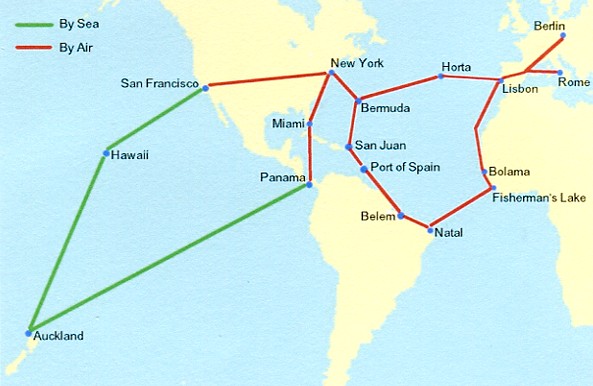
The usual route from New York to Lisbon was via Bermuda and Horta (Azores). In reverse, that was the usual summer route from Lisbon to New York. However, in the winter, the route from Lisbon was via West Africa, Brazil, Trinidad, Puerta Rica and Bermuda to New York.
POW air mail from Italian POW camps was flown from Rome to Lisbon by Ala Littoria while POW air mail from German POW camps was flown Berlin - Lisbon by Lufthansa.
Via the Agence Centrale des Prisonniers de Guerre, Geneva
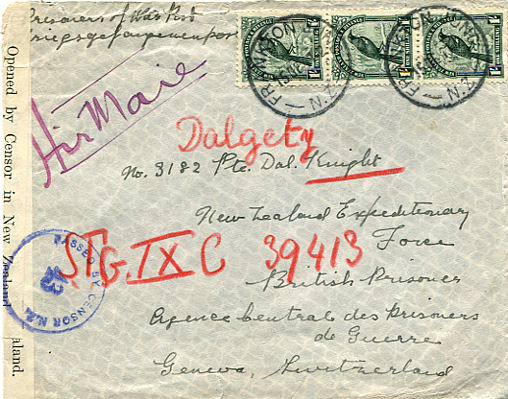
3s 0d rate
When the camp in which a POW was being held was not known, it was possible to write via the Agence Centrale des Prisonniers de Guerre run by the Red Cross in Geneva [2].
This cover is inscribed Prisoner of War Post / Kriegsgefangenenpost . It is franked at the concessionary 3s 0d rate, but as it is postmarked on 15 December 1941, it missed the last Pan American flight from New Zealand to USA. It would therefore have been sent by sea to the USA and flown from there to Lisbon.
It was censored in Auckland (No. 43), but there are no further censor marks. The route from Lisbon is likely to have been air to Barcelona and then by surface to Switzerland through Vichy France.
It has been redirected to the POW camp in which Private Knight was being held, in this case
Stalag IX C near Leipzig.
The cover may have been sent from Geneva to Zurich and flown from there
by Swissair to Berlin.
That service lasted from late November 1941 to early 1943.
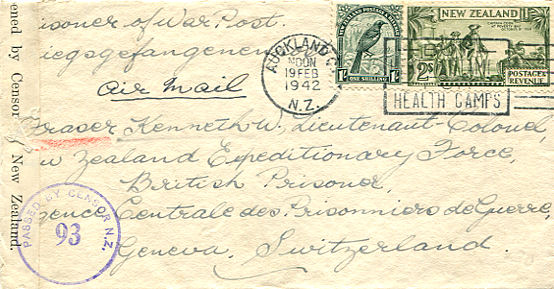
This next cover to the Agence Centrale des Prisonniers de Guerre, also franked with 3s 0d, is postmarked in February 1942, but has not been re-addressed. It was opened by the censors in Auckland (No. 93), but there are no further censor marks.
It may have gone by the same route to Geneva as the previous cover or, alternatively, by the new route via the Canal Zone that had been introduced in January 1942.
Lt. Col. Fraser was held as a POW, first in Italy and then in Germany.
The Wellington Evening Post of 4 July 1945
has comments by him on his return to New Zealand.
To Red Cross International Committee

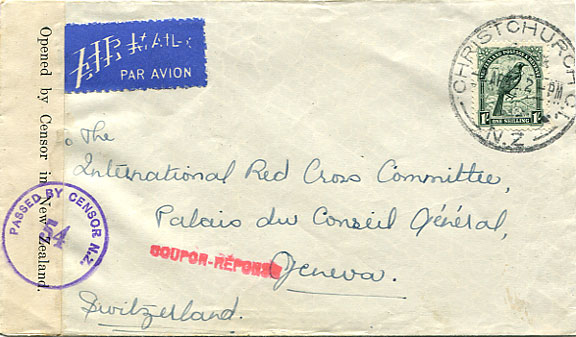
1s 0d rate
This censored cover is postmarked in Christchurch on 2 April 1942 and is addressed to the International Red Cross Committee in Geneva. It is franked with the concessionary POW air mail rate of 1s 0d and the route was surface to USA and then air to Lisbon.
The cover would likely contain an enquiry about the location of a POW and a forty word message could be included with the enquiry for onward transmission to the POW [6].
In an extension of this, the Red Cross Message Scheme enabled friends and relatives to communicate even though their respective countries were at war. There were special forms in which a message of not more than 25 words could be written. This went to the local Red Cross who arranged for it to be sent to the Red Cross in Geneva from where it was sent to the Red Cross in the recipient's country who arranged for it to be delivered. The recipient could then write a reply on the form which was then returned, again via the Red Cross [7,8]. The sender had to pay for postage in both directions and from New Zealand this was done by enclosing an International Reply Coupon which is the reason for the red Coupon Reponse cachet which was applied in Geneva.

There is a purple letter G on the back used as a code within the censors office [2].
Interestingly, although this cover is postmarked in Christchurch,the censor number is
54 which was used for POW mails in Wellington.
The Christchurch censor number for POW mails was 63 [2].
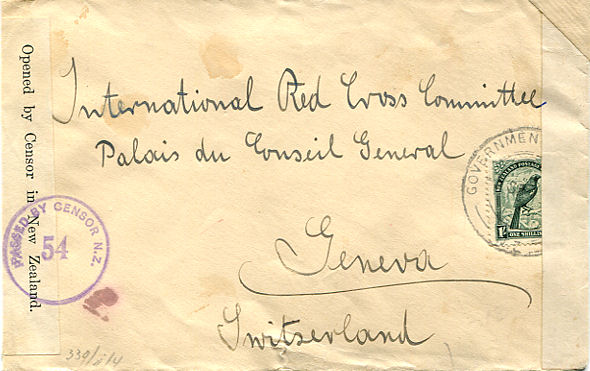
This cover to the International Red Cross Committee in Geneva was postmarked in September 1942 and was also franked with the concessionary 1s 0d rate.
Germany occupied Vichy France in November 1942 and after that air mail to Switzerland was sent to Paris to be censored. Although this cover was postmarked in September it apparently took quite a lot of time to reach France having been delayed by the actions of the censors.
It was first dealt with in Christchurch by the New Zealand censor 54 and this time has the internal code B on the back
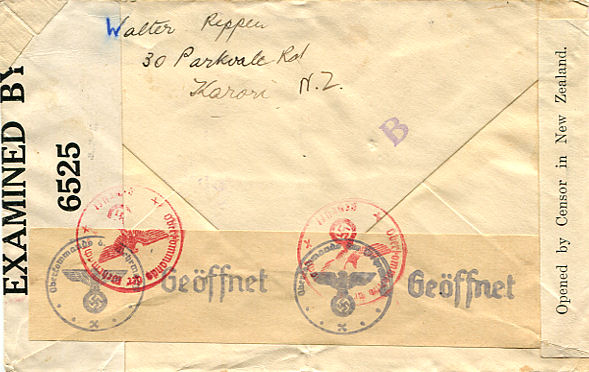
It was then opened and Examined by censor 6525 which was in New York. Finally it was opened by the German censor in Paris (code X).
A similar cover is shown in [4] with the comment that it is not clear that
the 1s 0d POW rate officially applied to letters to the Red Cross, but
its use was allowed by the New Zealand Post Office.
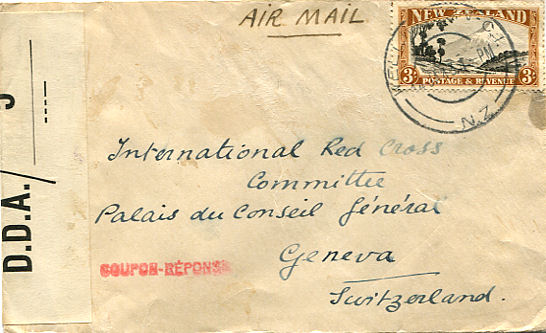
3s 0d rate
This cover to the International Red Cross Committee in Geneva was postmarked in Wellington on 14 January 1943 and was franked with the concessionary 3s 0d rate. It was opened and passed by the censor in Wellington (DDA 5).

As it was sent after November 1942, it had to go through German occupied France. Because it was addressed to the Red Cross, it was not opened by the censors, but has the backstamp A.x. to show that it had been dealt with by the German censors. The A stands for Ausland Brief Prufstelle which translates as: Overseas Letter Censor Office while x is the German censor code for Paris. Such mail was dealt with in Paris from 21 January 1943 [6].
There is a Coupon Reponse red handstamp that was applied on arrival
in Geneva to show that the letter contained an International Reply Coupon (IRC)
to pay for return postage.
New Zealand to Italy
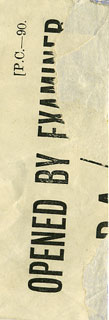
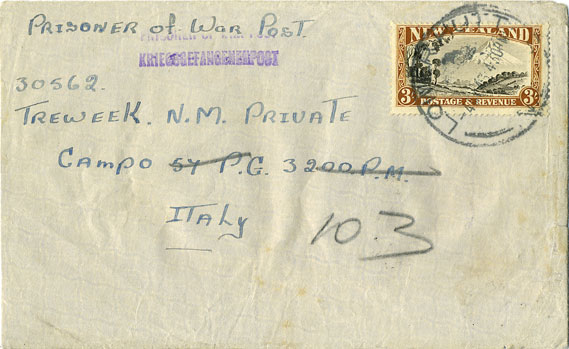
When the Pan American flights from Auckland to San Francisco ceased in December 1941, the 2s 0d rate was dropped. However, the 3s 0d rate remained in existence and on 1 August 1942, the New Zealand Post Office explained its purpose as being by air as far as circumstances permit [2].
This cover, postmarked in Lower Hutt on 3 May 1943, is addressed to a POW in a camp in Italy and is franked with 3s 0d. It is likely to have gone by sea to Panama, air to New York and then flown trans-Atlantic to Lisbon.
It may then have been flown from Lisbon. It has a two line purple cachet Prisoner of War Post / Kriegsgefangenenpost, which I think would have been applied in New Zealand. It was opened by the censor in New Zealand, but has no further censor or routing markings.
As POW airletter cards were introduced in November 1941 at a rate of 1s 6d (reduced from March 1943 to 1s 0d) it would appear that the 3s 0d rate was little used.
Italy to New Zealand
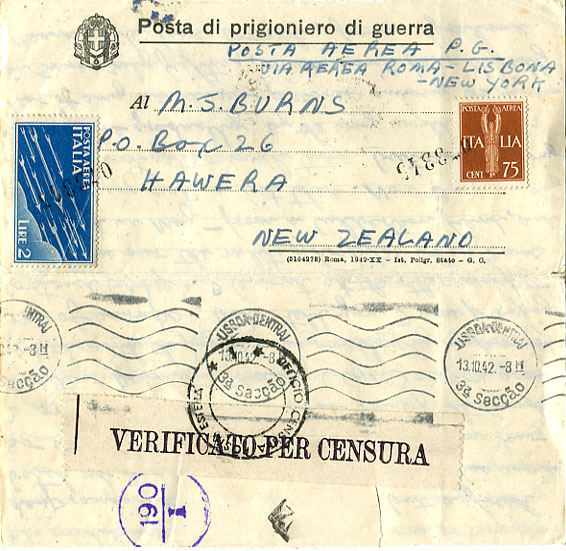
Prisoners of War could send surface mail free, but air mail was charged.
This prisoner of war air mail letter form Posta di prigioniero di guerra is addressed to New Zealand and is franked with 2L 75c. It was opened by the censors in Italy with censor marks 190/I and a Verificato Per Censura censor tape with a Ufficio Censura Posta Estera handstamp. All Italian POW censorship took place in Rome [5].
Air mail to New Zealand from prisoners of war in Italy was flown from Rome to Lisbon via Barcelona and Madrid by Ala Littoria and then flown Lisbon - New York by Pan American. The winter route was via West Africa and South America. The final leg across the Pacific was by sea.
The letter is dated 4th October 1942 and was from Campo PG 52 which was in Calvari, near Genoa. As was usual with Italian POW mail, it does not have a dated postmark although and has a Lisbon transit mark on 13th October. There is a note in manuscript on the back that it was received on 6th January 1943.
It therefore made very good time from the POW Camp to Lisbon (9 days),
but the transit time after that was less good (84 days).
There is no US censor mark.
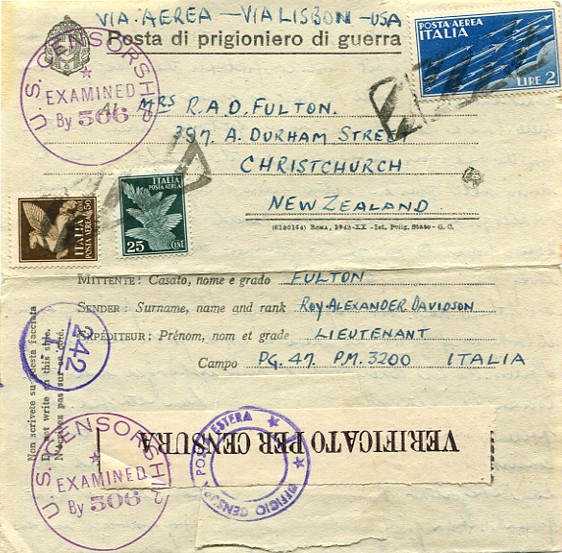
Air mail to New Zealand from prisoners of war in Italy was flown from Rome to Lisbon via Barcelona and Madrid by Ala Littoria and then flown Lisbon - New York by Pan American. The cover was from Camp PG 47 which was in Modena. As it is dated 24 December 1942, it would be flown to New York via West Africa and South America after being flown from Rome to lisbon. The final leg across the Pacific was by sea.
As with the previous cover, it was opened by the censors in Rome with a Verificato Per Censura censor tape and a Ufficio Censura Posta Estera handstamp. The censor mark is 242/I.
Unlike the previous cover, it does not have a Lisbon transit mark, but it does have a US censor mark which was applied in Chicago.
The air mail letter form has been updated and has more information on the front.
Many POWs in Italy were moved to Germany after Italy surrendered
in September 1943.
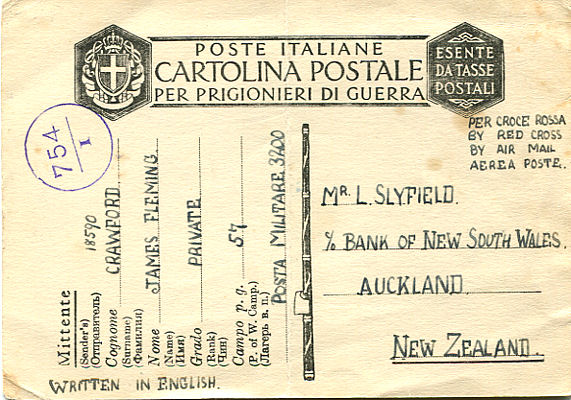
This next item is a prisoner of war postcard and has By Red Cross and By Air Mail in manuscript in both English and Italian.
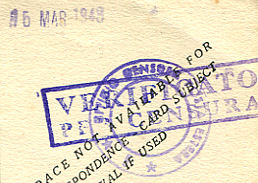
It has the censor mark 754/I on the front and the other censor marks on the back. Censorship took place in Rome.
There is also the date 15 Mar 1943, but it is not clear where that was applied.
There are no further transit marks, but it would go by the same route as air mail letter.
Germany to New Zealand
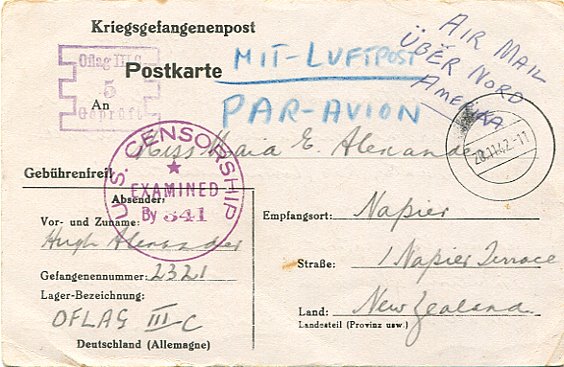
This Kriegsgefangenenpost Postkarte from a POW in Germany is postmarked on 20 November 1942 and was sent from Offlag IIIC which was situated in Lubben, Brandenburg near the Polish border.
It has Air Mail uber Nord Amerika in manuscript on the front as well as Mit Luftpost and Par Avion in blue pencil. Ordinary mail was free while air mail cost 40 RPf.
From March 1942 POW air mail was flown from Berlin via Stuttgart, Barcelona and Madrid to Lisbon and from there by Pan American to New York while surface mail went via Istanbul to Baghdad [1]. This cover would be flown from Lisbon to New York on the winter route via West Africa and South America.
Air mail cards normally had a handstamp certifying that the air mail fee had been paid,
but there is nothing on this card.
However, the card has a US Censorship handstamp proving that it did indeed go via North
America.
US censorship for POW air mail was in Chicago.
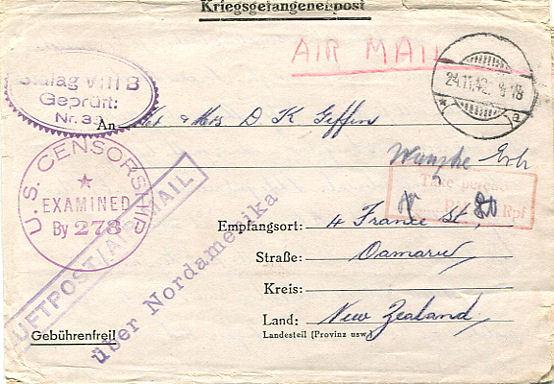
This Kriegsgefangenenpost lettersheet is postmarked 24 November 1942 although the letter inside is dated 29th October.
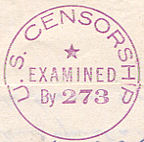
It was sent from Stalag VIIIB which was situated at Lamsdorf in Silesia.
Although the normal air mail fee was 40Rpf, this cover has Taxe percue - RM 80 Rpf to show that twice the rate had been paid.
The lettersheet has a similar Chicago US Censorship handstamp to the above cover proving that it did
indeed go via North America.
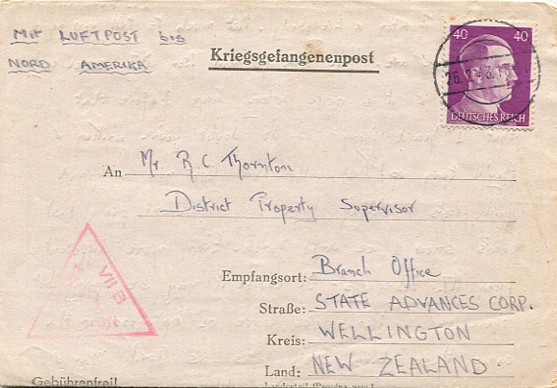
This Kriegsgefangenenpost lettersheet is postmarked 26 February 1943 and was sent from Kriegsgef.-Offizierlager (Oflag) VII B which was located in Eichstatt in Bavaria.
Whereas most POW air mail from Germany had the air mail fee of 40Rpf denoted by a handstamp, this example has a 40Rpf postage stamp.
It has Mit Luftpost bis Nord Amerika in manuscript and a red triangular
Oflag VII B Gepruft handstamp but it has no further
transit marks.
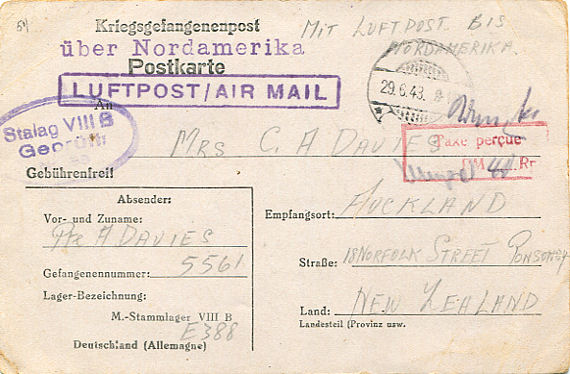
This POW card is addressed to Ponsonby in New Zealand and was also sent from Stalag VIIIB which was situated at Lamsdorf in Silesia.
It is postmarked 29th June 1943 although the message is dated 30th May. Hence, as with the previous cover, there was a gap of almost a month between the letter being written and it being postmarked.
It has Taxe percue - RM 40 Rpf to note that the air mail charge had been paid.
It also has the same uber Nordamerika, boxed
Luftpost / Air Mail and Stalag VIIIB Gepruft (i.e. examined) handstamps
as the previous cover
as well as Mit Luftpost bis Nordamerika in manuscript.
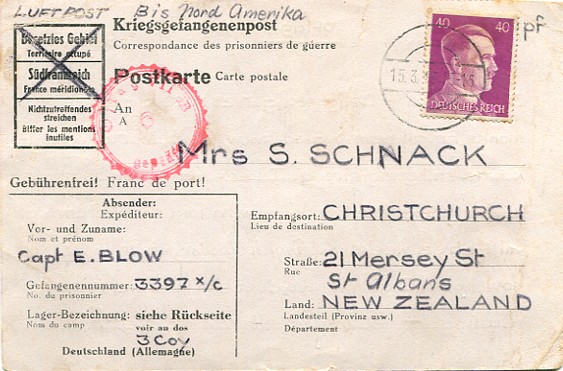
This Kriegsgefangenenpost Postkarte is postmarked on 15 March 1944 and is addressed to Christchurch in New Zealand with routing instructions Luftpost Bis Nord Amerika.
It is franked with a 40RPf stamp. It has a rather indistict red handstamp with the address Oflag VII B which is the same camp as the previous item which had a postage stamp. An Oflag was a POW camp for officers and this card is from a Captain.
If it was flown from Lisbon on, or before, 3 April 1944, it would have gone by the 1943/44 winter route: Lisbon - Dakar (Senegal)
- Natal (Brazil) - Balem - Port of Spain (Trinidad) - Bermuda - New York.
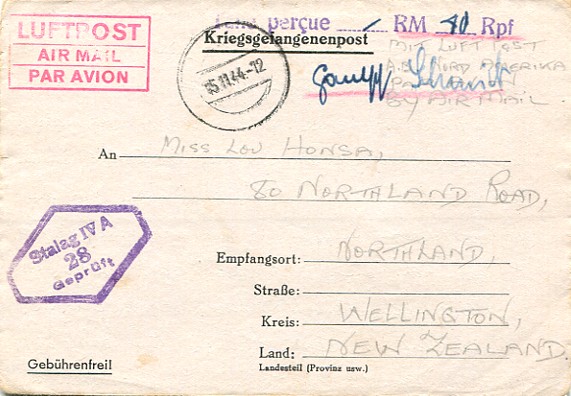
This lettercard is postmarked on 5 November 1944 and is addressed to Wellington. It has a red Luftpost / Air Mail / Par Avion and Tax Percue / RM 40 Rpf handstamps, but does not have routing instructions.
It was sent from Stalag IV A which was near Dresden.
As this cover was sent after D-Day, the flight to Lisbon by Lufthansa was no
longer possible, but POW mail was still sent via the USA.
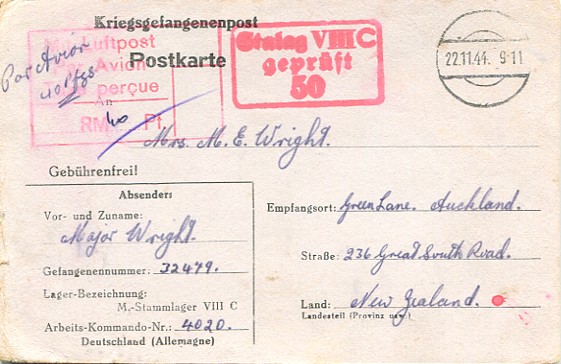
This Kriegsgefangenenpost Postkarte is postmarked on 22 November 1944 and is addressed to Auckland. It has an integrated red Luftpost / Par Avion / Tax Percue / RM Pf handstamp, but like the previous cover, it does not have routing instructions.
It was sent from Stalag VIII C which was at Sagan, Germany which is now in Poland.
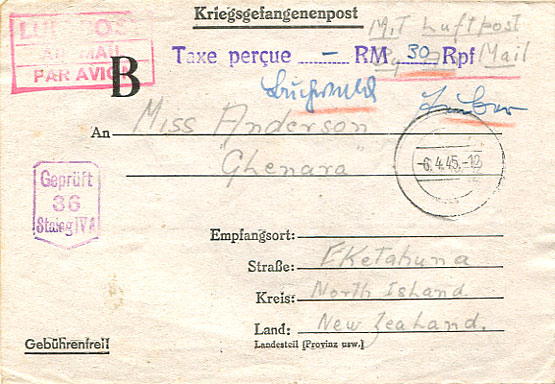
This lettersheet is also routed to be sent by air mail to New Zealand and so would have been expected to have been flown to North America. It is postmarked at on 6 April 1945 at Stalag IVA which was at Hohenstein-Ernstthal near Dresden.
The POW air mail fee to Australia and New Zealand had been reduced to 30RPf in January 1945 and the lettersheet has Taxe percue - RM 30 RPf inscribed on the front.
By this time, allied forces were advancing through Germany and so postal services were in disarray. It is therefore not clear which route was taken by this lettersheet.
Stalag IVA was liberated a month later in May 1945.
[1] Airmail Stationery used by and for POW and Internees during World War II
G. Pohlig and N.M.Russell, Postal History 2000, 1996.
[2] The Postal History of World War II Mail between New
Zealand and Switzerland, R.M. Startup and C.J. LaBlonde, 2005.
[3] Airmails of New Zealand, volume 3, R.M. Startup, 1997.
[4] Airmail Routes and Rates for P.O.W Mail in World War II,
G. Branam, The Kiwi, vol 38, pp 34-38, March 1989.
[5] Letters Home - Prisoner of War Mail from Italy and Germany, G. Branam,
New Zealand - A Philatelic Miscellany, A Berry (Editor), Pub. New Zealand
Society of Great Britain, 1990.
[6] Additional Censor Markings, E.W. Leppard, The Kiwi, vol 38, pp 51-53, May 1989.
[7] Mail to Geneva, The Red Cross Postal Message Scheme During World War II,
J.J.Danielski and C. LaBlonde, Tell, vol 22, no 6, pp 1, 12-15,
November 1996, American Helvetia Philatelic Society.
[8] Air Mail Operations During World War II, T.H. Boyle, American Air Mail Society, 1998.